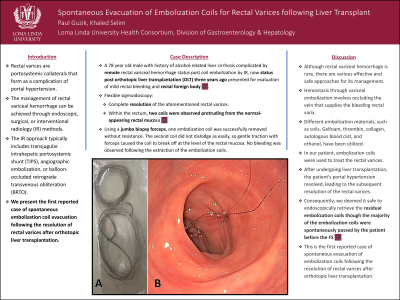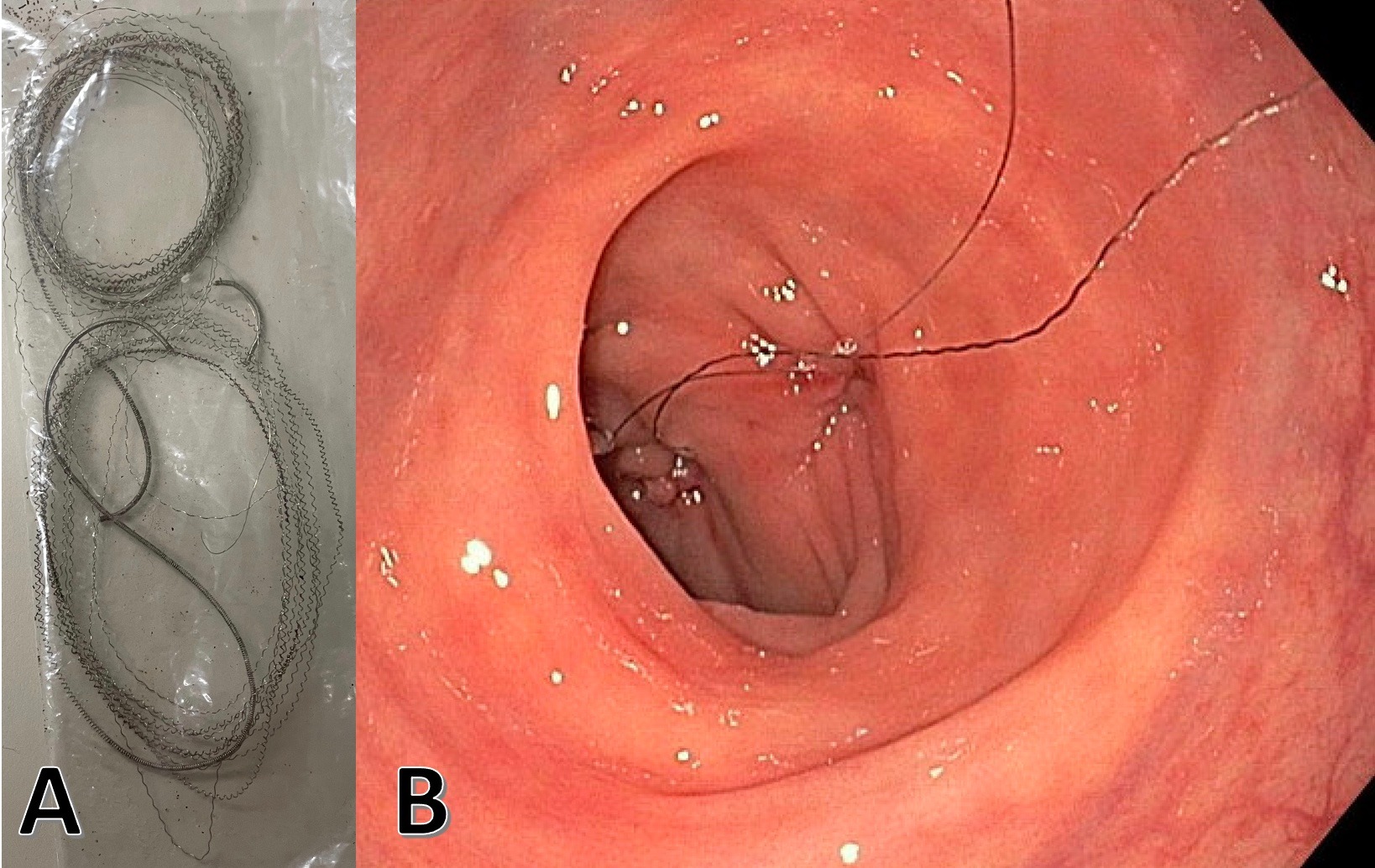Tuesday Poster Session
Category: Liver
P3934 - Spontaneous Evacuation of Embolization Coils for Rectal Varices Following Liver Transplant
Tuesday, October 24, 2023
10:30 AM - 4:00 PM PT
Location: Exhibit Hall

Has Audio

Paul Guzik, DO
Loma Linda University
Redlands, CA
Presenting Author(s)
Paul Guzik, DO1, Khaled Selim, MD2
1Loma Linda University, Redlands, CA; 2Loma Linda University, Loma Linda, CA
Introduction: Rectal varices are portosystemic collaterals that form as a complication of portal hypertension. The management of rectal variceal hemorrhage can be achieved through endoscopic, surgical, or interventional radiology (IR) methods. The IR approach typically includes transjugular intrahepatic portosystemic shunt, angiographic embolization, or balloon-occluded retrograde transvenous obliteration. We present the first reported case of spontaneous embolization coil evacuation following the resolution of rectal varices after orthotopic liver transplantation.
Case Description/Methods: A 78 year old male with history of alcohol-related liver cirrhosis complicated by remote rectal variceal hemorrhage status post coil embolization by IR, now status post orthotopic liver transplantation (OLT) three years ago presented for evaluation of mild rectal bleeding and rectal foreign body. The patient was scheduled for a flexible sigmoidoscopy, which revealed complete resolution of the previously mentioned rectal varices. Within the rectum, two coils were observed protruding from the normal-appearing rectal mucosa. Using a jumbo biopsy forceps, one embolization coil was successfully removed without resistance. The second coil did not dislodge as easily, so gentle traction with forceps caused the coil to break off at the margin of the rectal mucosa. No bleeding was observed following the extraction of the embolization coils.
Discussion: Although rectal variceal hemorrhage is rare, there are various effective and safe approaches for its management. Hemostasis through variceal embolization involves occluding the vein that supplies the bleeding rectal varix. Different embolization materials, such as coils, Gelfoam, thrombin, collagen, autologous blood clot, and ethanol, have been utilized. In our patient, embolization coils were used to treat the rectal varices. After undergoing liver transplantation, the patient's portal hypertension resolved, leading to the subsequent resolution of the rectal varices. Consequently, we deemed it safe to endoscopically retrieve the remaining embolization coils. It is worth noting that the majority of the embolization coils were spontaneously passed by the patient before the endoscopy. We present the first reported case of spontaneous evacuation of embolization coils following the resolution of rectal varices after orthotopic liver transplantation.

Disclosures:
Paul Guzik, DO1, Khaled Selim, MD2. P3934 - Spontaneous Evacuation of Embolization Coils for Rectal Varices Following Liver Transplant, ACG 2023 Annual Scientific Meeting Abstracts. Vancouver, BC, Canada: American College of Gastroenterology.
1Loma Linda University, Redlands, CA; 2Loma Linda University, Loma Linda, CA
Introduction: Rectal varices are portosystemic collaterals that form as a complication of portal hypertension. The management of rectal variceal hemorrhage can be achieved through endoscopic, surgical, or interventional radiology (IR) methods. The IR approach typically includes transjugular intrahepatic portosystemic shunt, angiographic embolization, or balloon-occluded retrograde transvenous obliteration. We present the first reported case of spontaneous embolization coil evacuation following the resolution of rectal varices after orthotopic liver transplantation.
Case Description/Methods: A 78 year old male with history of alcohol-related liver cirrhosis complicated by remote rectal variceal hemorrhage status post coil embolization by IR, now status post orthotopic liver transplantation (OLT) three years ago presented for evaluation of mild rectal bleeding and rectal foreign body. The patient was scheduled for a flexible sigmoidoscopy, which revealed complete resolution of the previously mentioned rectal varices. Within the rectum, two coils were observed protruding from the normal-appearing rectal mucosa. Using a jumbo biopsy forceps, one embolization coil was successfully removed without resistance. The second coil did not dislodge as easily, so gentle traction with forceps caused the coil to break off at the margin of the rectal mucosa. No bleeding was observed following the extraction of the embolization coils.
Discussion: Although rectal variceal hemorrhage is rare, there are various effective and safe approaches for its management. Hemostasis through variceal embolization involves occluding the vein that supplies the bleeding rectal varix. Different embolization materials, such as coils, Gelfoam, thrombin, collagen, autologous blood clot, and ethanol, have been utilized. In our patient, embolization coils were used to treat the rectal varices. After undergoing liver transplantation, the patient's portal hypertension resolved, leading to the subsequent resolution of the rectal varices. Consequently, we deemed it safe to endoscopically retrieve the remaining embolization coils. It is worth noting that the majority of the embolization coils were spontaneously passed by the patient before the endoscopy. We present the first reported case of spontaneous evacuation of embolization coils following the resolution of rectal varices after orthotopic liver transplantation.

Figure: A. Embolization coils patient passed spontaneously at home
B. Endoscopic view of residual embolization coils protruding from normal appearing rectal mucosa
B. Endoscopic view of residual embolization coils protruding from normal appearing rectal mucosa
Disclosures:
Paul Guzik indicated no relevant financial relationships.
Khaled Selim indicated no relevant financial relationships.
Paul Guzik, DO1, Khaled Selim, MD2. P3934 - Spontaneous Evacuation of Embolization Coils for Rectal Varices Following Liver Transplant, ACG 2023 Annual Scientific Meeting Abstracts. Vancouver, BC, Canada: American College of Gastroenterology.
